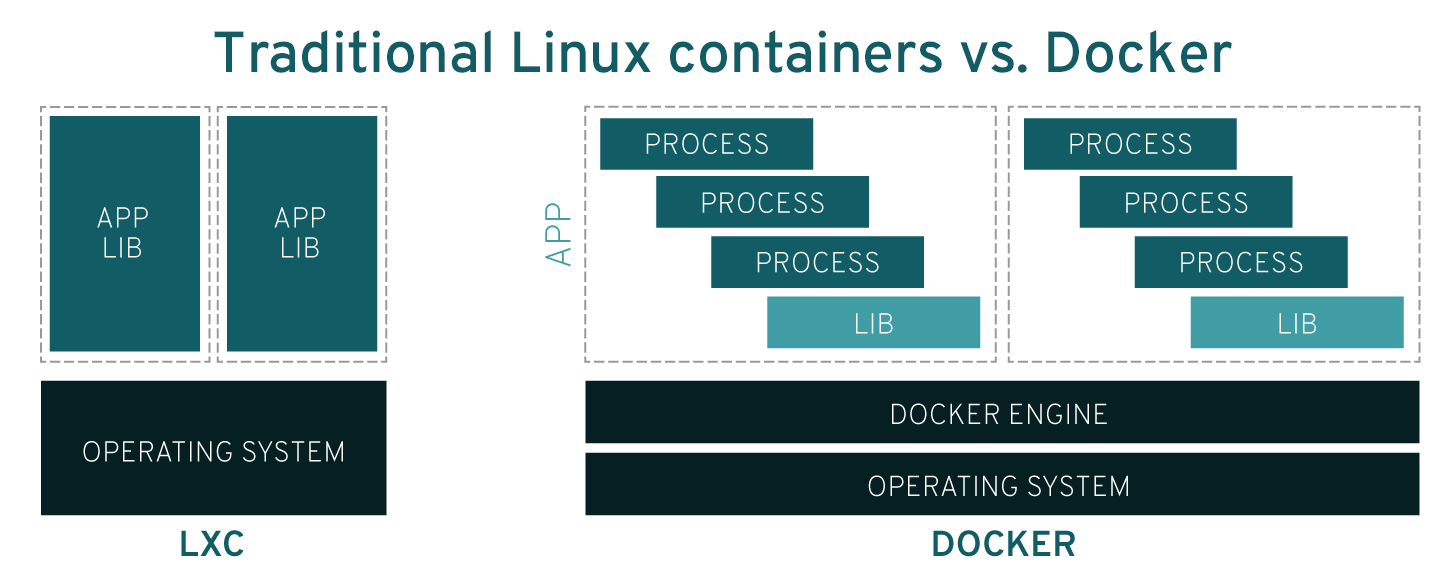Overview
The word "Docker" refers to several things, including an open source community project; tools from the open source project; Docker Inc., the company that primarily supports that project; and the tools that company formally supports. The fact that the technologies and the company share the same name can be confusing.
Here's a brief explainer:
- The IT software "Docker” is containerization technology that enables the creation and use of Linux® containers.
- The open source Docker community works to improve these technologies to benefit all users.
- The company, Docker Inc., builds on the work of the Docker community, makes it more secure, and shares those advancements back to the greater community. It then supports the improved and hardened technologies for enterprise customers.
With Docker, you can treat containers like extremely lightweight, modular virtual machines. And you get flexibility with those containers—you can create, deploy, copy, and move them from environment to environment, which helps optimize your apps for the cloud.
Docker vs. Linux containers: Is there a difference?
Although sometimes confused, Docker is not the same as a traditional Linux container. Docker technology was initially built on top of the LXC technology—which most people associate with "traditional" Linux containers—though it’s since moved away from that dependency. LXC was useful as lightweight virtualization, but it didn’t have a great developer or user experience. The Docker technology brings more than the ability to run containers—it also eases the process of creating and building containers, shipping images, and versioning of images, among other things.
Traditional Linux containers use an init system that can manage multiple processes. This means entire applications can run as one. The Docker technology encourages applications to be broken down into their separate processes and provides the tools to do that. This granular approach has its advantages.
Advantages of Docker containers
Modularity
The Docker approach to containerization focuses on the ability to take down a part of an application to update or repair, without having to take down the whole app. In addition to this microservices-based approach, you can share processes among multiple apps in much the same way service-oriented architecture (SOA) does.
Layers and image version control
Each Docker image file is made up of a series of layers that are combined into a single image. A layer is created when the image changes. Every time a user specifies a command, such as run or copy, a new layer gets created.
Docker reuses these layers to build new containers, which accelerates the building process. Intermediate changes are shared among images, further improving speed, size, and efficiency. Also inherent to layering is version control: Every time there’s a new change, you essentially have a built-in changelog, providing you with full control over your container images.
Rollback
Perhaps the best part about layering is the ability to roll back. Every image has layers. Don’t like the current iteration of an image? Roll it back to the previous version. This supports an agile development approach and helps make continuous integration and deployment (CI/CD) a reality from a tools perspective.
Rapid deployment
Getting new hardware up, running, provisioned, and available used to take days, and the level of effort and overhead was burdensome. Docker-based containers can reduce deployment to seconds. By creating a container for each process, you can quickly share those processes with new apps. And, since an operating system doesn’t need to boot to add or move a container, deployment times are substantially shorter. Paired with shorter deployment times, you can easily and cost-effectively create and destroy data created by your containers without concern.
So, Docker technology is a more granular, controllable, microservices-based approach that places greater value on efficiency.
Are there limitations to using Docker?
Docker, by itself, can manage single containers. When you start using more and more containers and containerized apps, broken down into hundreds of pieces, management and orchestration can get difficult. Eventually, you need to take a step back and group containers to deliver services—networking, security, telemetry, and more—across all of your containers. That's where Kubernetes comes in.
With Docker, you don’t get the same UNIX-like functionality that you get with traditional Linux containers. This includes being able to use processes like cron or syslog within the container, alongside your app. There are also limitations on things like cleaning up grandchild processes after you terminate child processes—something traditional Linux containers inherently handle. These concerns can be mitigated by modifying the configuration file and setting up these abilities from the start–but that may not be obvious at a first glance.
On top of this, there are other Linux subsystems and devices that aren’t namespaced. These include SELinux, Cgroups, and /dev/sd* devices. This means that if an attacker gains control over these subsystems, the host is compromised. In order to stay lightweight, the sharing of the host kernel with containers opens this possibility of a security vulnerability. This differs from virtual machines, which are much more tightly segregated from the host system.
The Docker daemon can also be a security concern. To use and run Docker containers, you’ll most likely be using the Docker daemon, a persistent runtime for containers. Docker daemon requires root privileges, so special care must be taken regarding who gets access to this process and where the process resides. For example, a local daemon has a smaller attack surface than one that lives in a more public location, such as a web server.


